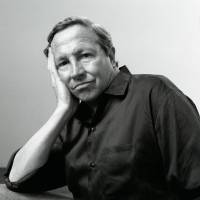(1925-2008)

Follow Robert RAUSCHENBERG
Robert Rauschenberg was born October 22, 1925, in Port Arthur, Texas.
After studying pharmacy at the University of Texas at Austin, he was incorporated into the United States Army during the Second World War. He joined the Navy Hospital Corps of San Diego in California. Rauschenberg enrolled at the Kansas City Art Institute where he studied painting, art history, composition, sculpture, music, anatomy and fashion from 1947 to 1948.
He then studied art in Paris and in the center in the United States.
In 1952, he participated in the first Happening in art history, initiated by John Cage and left for a stay in Europe and North Africa with the artist Cy Twombly. He has created collages that announce his method of combining disparate themes, most of which will definitely take their place in his iconographic register.
A son returned, he moved to New York where he met Jasper Johns.
From 1954 to 1964, he collaborated with the Merce Cunningham Company as artistic director, as well as costumes and sets, taking care of the lighting and the stage management of major ballets.
It is the erasure of a drawing by Kooning in 1953 (Erased) that deeply influences Rauschenberg. He visited Alberto Burri in Rome and created the Combine Paintings from an attempt to rewrite art for art (through total openness).
He began to explore the technique of transfer with solvent in his drawing work in 1958 (34 Drawings for Dante’s ‘Inferno’) a series of photographs washed out by solvent.
His first retrospective exhibition in a museum took place in 1963 at the Jewish Museum in New York. He is developing a new technique by applying lithography to the industrial processing of serigraphic screens for the transfer of serigraphic screens. In 1963, he designed the choreography and danced himself in Pelican. In 1964, he traveled again to Europe, then to Asia with the dance company Merce Cunningham. The same year, an exhibition was devoted to him in London (Whitechapel Gallery) and at the Venice Biennale where he was the first American artist to win the Grand Prix.
He made the cover of Time magazine on November 29, 1976. Then he went back to photography. The Pompidou Center in Paris devoted an exhibition to him in 1981, then the Guggenheim in 1997 and finally the Metropolitan Museum in 2005.
Rauschenberg then explores the use of metal as a medium for painting, enamel and screen-printed images. The images and objects found refer to the artist's travels, while the polished metal surfaces reflect the immediate environment of the works.
He died on May 12, 2008 in Captive Iceland, Florida.

Secure payment
3DSecure 2.2

Free DHL Express delivery from €1,200
Carefully prepared parcel
Parcel tracking

Shipment insured
for the value of the artwork, covering theft and damages

Fairest prices
Certificate of authenticity
Two galleries in Paris
Receive an email as soon as a new artwork is added for this artist
Your message has been sent ! We will get back to you as soon as possible.
Please fill in the form if you need further information such
Please fill in your email address, an email will be sent with a link to update your password.
You can now place orders and track your orders.